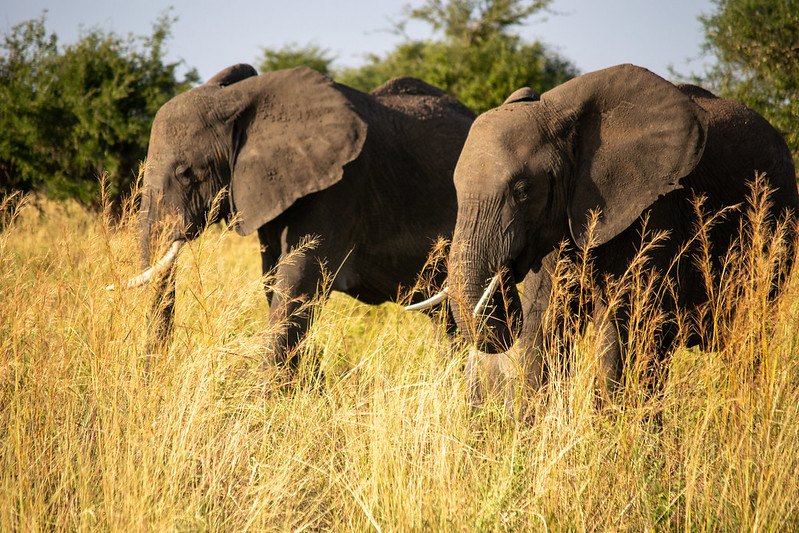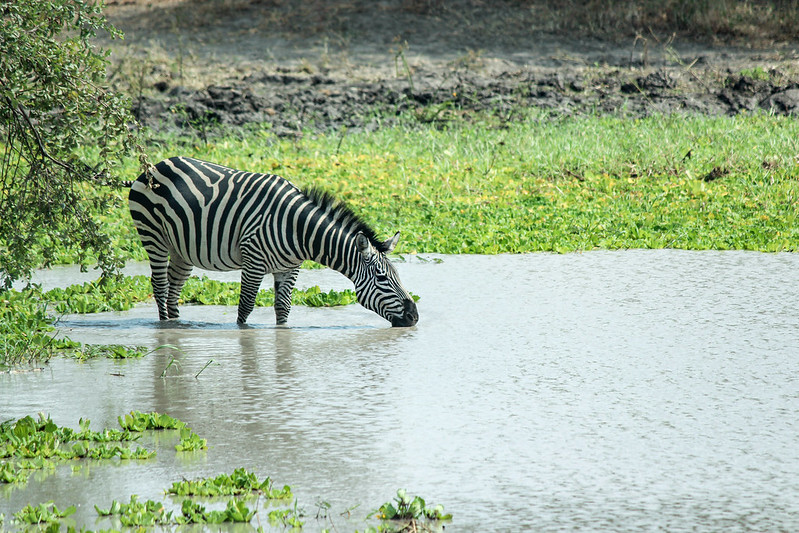Tanzania is one of the best places to experience safari. Safe, accessible and populated with incredible wildlife, including the Big Five, it is also one of Africa’s most popular safari destinations. Tanzania’s Serengeti National Park is a particular favourite, as it is one of only two places you can witness the Great Migration. The Serengeti has also been voted as the best safari destination in Africa more times than any other safari destination.
Tanzania’s best safari parks can be split into two groups - the Northern Circuit and the Southern Circuit and both offer incredible game viewing opportunities. The Northern Circuit is the most popular and it’s worth remembering that, as a popular safari destination, large crowds can be expected, especially during the high season from July - September. If you want to avoid crowds, I recommend the Southern Circuit, which typically sees fewer numbers than the Northern Circuit, whose destinations are known for being the best places to spot the Big Five.
About the Northern Circuit:
Tanzania’s Northern Circuit includes the Serengeti, Ngorongoro, Tarangire and Lake Manyara. All of these locations are known for the Big Five, and the Serengetti is best known as the place to go for a front row seat to the Great Migration. Safari parks in the Northern Circuit are the most popular in the country, as the locations are easy to access, with more accommodation and flight options and cheaper prices than safari destinations in the Southern Circuit. The Northern Circuit also offers the best game viewing options for the Big Five. Due to the popularity of the Northern Circuit, small group tours are frequent, increasing your chance of finding one to join. Here's a little about each of the safari parks included in the Northern Circuit.
The major downside of the Northern Circuit is that the popularity of these areas has led to large crowds, which may detract from an authentic safari experience if you don’t like crowds.

Serengeti National Park
Most people have heard of Serengeti National Park, and for good reason! Every year, it plays host to the largest animal migration in the world. More than 1.5 million wildebeest, 250,000 zebra and thousands of lions cross the plains in search of water and food as the season changes. The Great Migration can lead to exciting scenes as big cats hunt the bountiful prey and herds make fraught crossings of rivers infested with hungry crocodiles! Such scenes are bucket list items for many adventurous travellers. The best time to see the Great Migration in the Serengeti is January - March, when the herds are giving birth in the southern area.
Ngorongoro Conservation Area
Ngorongoro Conservation Area is a World Heritage Site, which includes the famous Ngorongoro Crater - the world’s largest unbroken, unflooded caldera, formed by a massive volcanic eruption millions of years ago! It is also one of the best places to see the Big Five. However, due to the popularity of the Ngorongoro Crater, this area can get extremely busy, so I’d advise scheduling a short stop of one - two days here to see the crater, before heading to the Serengeti for a longer safari.
Tarangire National Park
The Tarangire National Park’s unique landscape is breathtaking. Tarangire is known as much for the Big Five as it is for its large collection of distinctive baobab trees, which create an amazing landscape for a walking safari. During the dry season, the Tarangire River is the only source of water in the area, providing great opportunities for game spotting. In fact, herds of up to 300 elephants have been spotted in the park! Although immensely popular, Tarangire is one of the quieter safari parks on the Northern Circuit, and I highly recommend a one - two day safari in Tarangire.
Lake Manyara
Lake Manyara is known for its large elephant population, and for offering both land and water safaris. A canoe safari is a great way to get a different perspective and see some animals you might miss if you stayed on land. Big cats live in this area, but are quite elusive, so if they’re at the top of your list of things to see, this may not be the place for you. Lake Manyara is best enjoyed early in the morning, particularly during high season, with massive crowds gathering for safaris most afternoons.
About the Southern Circuit:
The Southern Circuit includes the Selous Game Reserve and the Ruaha National Park. The Southern Circuit offers fewer lodge options than further north, but that does not mean you have to miss out on your creature comforts. While there are still many fantastic lodges across Selous and Ruaha parks, they are significantly fewer in number than you’ll find in the Northern Circuit. These areas feel remote, receiving less tourist traffic than those in the Northern Circuit and providing an off the beaten track safari experience that feels more authentic. This area is also home to some animals you won’t see further north, such as wild dogs. The downside of the Southern Circuit is that safaris in these areas are more expensive than those further north, because the areas is more remote. The expense is absolutely worth it if you want to avoid the crowds, or if you want a more authentic safari experience because the animals are less used to tourists. Here is a summary of the Southern Circuit's main parks.

Selous Game Reserve
The Selous Game Reserve is a lesser-known area, but it is actually Africa’s largest game reserve, spanning approximately 48,000 square kilometres - that’s about three times the size of the Serengeti! While only a small portion of that is actually accessible to tourists on safari, you can still expect to see plenty of wildlife, including the Big Five, in a setting that feels truly remote. Walking and boat safaris are available, as well as fly-camping for a very wild and adventurous trip.
Ruaha National Park
A hidden gem, Ruaha National Park houses East Africa’s largest elephant population and 10% of all of Africa’s lions! Situated right where East Africa meets the south, the wildlife here is particularly diverse. You can spot the Big Five, as well as rare wild dogs, leopards and large prides of lions.
Price
The average cost of safari in Tanzania will depend on the amount of luxury you’d like to enjoy on your trip. As with all safaris, cost is influenced most by the accommodation and creature comforts that you choose. While it is possible to find a budget safari in Tanzania for as little as USD$200pp/day, I recommend paying a little extra for a mid-range safari, which will costs between USD$300-$500pp/day. Luxury safari prices in Tanzania begin at USD$500pp/day.
Weather
With its tropical climate, Tanzania has two major seasons - the wet season and the dry season. Conditions depend on a variety of factors, including altitude and proximity to the coast. Coastal areas tend to be hotter and more humid, while elevated areas of the country’s interior are more mild and can cool down significantly at night.
1. Dry Season
Dry season is the high season for safari in Tanzania, lasting from June to October. During this time, it is generally clear and sunny with temperatures varying between 20 and 30 degrees. Warm clothes are advisable, especially if you’re heading out on a morning safari.
2. Wet Season
During the wet season, temperatures reach 30 degrees through the day, but humidity is higher than during the dry season. Between November to December, the “short rains” arrive. There is a short reprieve between January and February, before the “long rains” begin in March and continue through into May. During March - May, it tends to rain heavily almost every day in Tanzania and it is not advisable to safari during this period.

Best time of year
- January to March: Calving season
January to March is the best time to go on safari in Tanzania because it is calving season in the Serengeti. At this time of year, the Great Migration herds slow down and mothers give birth to their calves. This is a great time of year to see young animals taking their first steps. Babies wildebeest also bring a lot of big cats!
- June to August: Peak season
Late June to early August is the also a great time to go on safari, especially in the Serengeti, as this is when the Great Migration occurs. The north-western Serengeti is the best place to be for the beginning of the migration, between late June and July. In August, the migration moves into the northern Serengeti. This is where you can catch a glimpse of herds making the perilous journey across the crocodile-infested Mara River into Kenya.
- September to October
The Great Migration moves into Kenya throughout September & October, so animal sightings become less frequent. While you may catch the last of the Great Migration in early September, if you want to go on safari at this time of year, I think you’re better off looking at the Masai Mara in Kenya.
- November to December: Short rains
The short rains arrive through November to December, and the herds begin to return to the Serengeti following the Great Migration. This is a good time of year to avoid crowds, but still see plenty of wildlife.
- April to May: Long rains
The long rains are not an advisable time of year to go on safari, as roads can become flooded and riddled with potholes. Many tours also don’t operate during this time, and some camps and lodges close during this season.
Number of international tourists:
Tanzania receives approximately 1 - 2 million tourists each year. This means you can expect some crowding during peak season, but nothing like you see in Europe, Asia or South America. To put this into perspective, Italy receives 65 million, USA 80 million, and Egypt, South Africa & Australia 10 million tourists each year. The best way to avoid the crowds is to travel in shoulder season (June, March or September - October), and book your accommodation at boutique safari lodges.
Other experiences in Tanzania (or nearby):
Tanzania offers most of Africa's best adventures. From the best safari in Africa, to Mt Kilimanjaro, Zanzibar, chimpanzees and whale sharks, Tanzania has something for everyone. Here are a few of my favourite adventures:
- Cultural immersions with the Maasai
- Mt Kilimanjaro & Mt Meru treks
- Chimpanzee trekking at Gombe Stream National Park
- Zanzibar's historic Stone Town and pristine white beaches
- Swimming with whale sharks on Mafia Island
- Ol Doninyo Lengai volcano
- Visit the life-changing School of St Jude (our Tanzanian charity partner)
After your safari in Tanzania, it is also very easy to visit other East African where you can:
- Trek with Gorillas in Rwanda or Uganda.
- Witness the Great Migration in Kenya
- White water raft in Uganda
- And much more.
Ready to start planning your african safari?
Check out our comprehensive guide to safari in Africa or book a consultation with an African safari experts to get an experts ideas and start planning your safari. Our private and custom-built luxury adventures are individually crafted to meet your wildest dreams! Secluded beach getaways, romantic safaris, honeymoon surprises, unique accommodation, or something a little weird and wonderful, tell us your wildest adventure dreams and we’ll make them a reality.